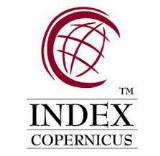
Comparative characteristics of the facial skull size of an adult, depending on the shape of the nose
Research article: Comparative characteristics of the facial skull size of an adult, depending on the shape of the nose
Authors: V.B. Shadlinsky*, S.A. Aliyeva
Department of Human Anatomy and Medical Terminology, Azerbaijan Medical University,
1 S.Vurgun str., Baku AZ1022, Azerbaijan; *For correspondence: medun91@mail.ru
Accepted for publication: 22 August 2019
Abstract: The craniometrical indicators of the facial skull were studied in 40 specially selected human skulls from the craniological collection of the fundamental museum of the human anatomy department of the Azerbaijan Medical University. It was established that among the studied skulls, mesoproseps prevail in the shape of the facial skull, and leptorrhines in the shape of the nose. In the female seri-es, a significant asymmetry was determined by the nazion-zygomaxillary indicator for chamerins left-sided, for leptorrhines right-sided, whereas in the mezorin group the asymmetry was right-si-ded and insignificant. A steady trend towards left-sided asymmetry was found in almost all indica-tors of the “side fan” in the men's series. The only exception was the distance from the point of the zygomaxillary to the lowest point of the pear-shaped hole, along which the right-sided asymmetry was noted in the male series.
Keywords: Asymmetry, facial skull, fan morphometry method, superscript face
References
Alekseyev V.P., Alekseyeva T.I. (1989) Anthro-pology in medicine. М.: Publ. Moscow Univer-sity, 243 p.
Borovikov V.P. (2015) Popular introduction to modern data analysis in the system STATISTI-CA. Moscow: Telecom, 288 p.
Dubovik Y.I. (2009) Asymmetry of the facial skull in its various forms in an adult: PhD. The-sis. St. Petersburg: 156 p.
Gayvoronsky I.V., Baybakov S.Y. (2008) Indi-vidual anatomical variability: Historical and methodological aspects. Journal of Experimen-tal and Clinical Surgery, 1: 65-72.
Gayvoronsky I.V., Dubovik Y.I., Kraynik I.V. (2009) Morphometric indicators of the asym-metry of the facial skull in an adult. Morpho-logy, 2: 74-79.
Hwang H., Yuan D., Jeong K. et al. (2012) Three-dimensional soft tissue analysis for the evaluation of facial asymmetry in normal occlusi-on individuals. Korean J. Orthod., 42(2): 56-63.
Khrappo N.S., Tarasova N.V. (1999) Nose in whole-skull system. Samara: San. SMU, 172 p.
Kibkalo A.P. (2006) Know Your Face. Volgog-rad. 150 p.
Koff E., Borod J.C., White O. (1981) Asymmet-ries for hemiface size and mobility. Neuropsyc-hologic., 19(6): 825-830
Martin R. (1928) Kraniologie a кraniometrische technik. Auft., Jena: 214вd
Nikolayeva Y.Y. (2007) Influence of the asym-metry of the facial skeleton on the severity of ano-malies of the dental system and its orthodontic cor-rection: Abstract. of PhD. Thesis. Tver: 21 p.
Nur R., Çakan D., Arun T. (2016) Evaluation of facial hard and soft tissue asymmetry using co-ne-beam computed tomography. Am. J. Orthod. Dentofacial Orthop., 149(2): 225-237.
Ponomareva T.V. (2010) Formation of functio-nal asymmetries in early ontogenesis: PhD The-sis. Krasnodar: 163 p.
Starbuck J., Ghoneima A., Kula K. (2014) Faci-al soft-tissue asymmetry in three-dimensional cone-beam computed tomography images of children with surgically corrected unilateral clefts. J. Craniofac. Surg., 25(2): 476-480.
Zhang Y., Che B., Ni Y. et al. (2013) Three-di-mensional condylar positions and forms associ-ated with different anteroposterior skeletal pat-terns and facial asymmetry in Chinese adoles-cents. Acta Odontol Scand., 71(5): 1174-1180.























